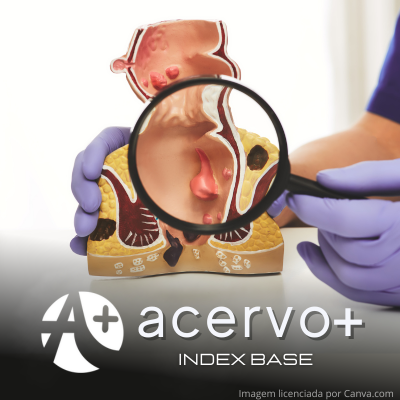Análise das características da Doença Hemorroidária
##plugins.themes.bootstrap3.article.main##
Resumo
Objetivo: Analisar as características da Doença Hemorroidária (DH). Revisão Bibliográfica: As hemorroidas são o prolapso distal do feixe arteriovenoso, fibras musculares e tecido conjuntivo circundante como um envelope abaixo da linha denteada no canal anal. Estas são uma das principais causas de hemorragia digestiva baixa e a patologia anorretal mais comum, com prevalência de até 40% na população geral, sendo a maior incidência observada em pacientes entre 45 e 65 anos. A fisiopatologia é multifatorial, incluindo: almofada anal deslizante; hiperperfusão do plexo hemorroidário; anormalidade vascular; inflamação tecidual; e prolapso retal interno (redundância retal). Considerações finais: A DH é uma condição que diminui a qualidade de vida dos indivíduos, estando associada a condições que causam o aumento da pressão no plexo venoso hemorroidário, tais quais fazer força durante a evacuação, gravidez, sexo anal, cirrose com ascite, disfunção do assoalho pélvico e dieta pobre em fibras e do hábito ocidental de passar mais tempo ao evacuar por ler durante o ato ou usar o celular. Nesse contexto, o tratamento é realizado de acordo com a gravidade da hemorroida podendo ser conservador ou cirúrgico.
##plugins.themes.bootstrap3.article.details##
Copyright © | Todos os direitos reservados.
A revista detém os direitos autorais exclusivos de publicação deste artigo nos termos da lei 9610/98.
Reprodução parcial
É livre o uso de partes do texto, figuras e questionário do artigo, sendo obrigatória a citação dos autores e revista.
Reprodução total
É expressamente proibida, devendo ser autorizada pela revista.
Referências
2. COHEE MW, et al. Benign Anorectal Conditions: Evaluation and Management. Am Fam Physician, 2020; 101(1): 24-33.
3. DE SCHEPPER H, et al. Belgian consensus guideline on the management of hemorrhoidal disease. Acta Gastroenterol Belg, 2021; 84(1): 101-120.
4. GALLO G, et al. Consensus statement of the Italian society of colorectal surgery (SICCR): management and treatment of hemorrhoidal disease. Tech Coloproctol, 2020; 24(2): 145-164.
5. GARDNER IH, et al. Benign anorectal disease: hemorrhoids, fissures, and fistulas. Ann Gastroenterol, 2020; 33(1): 9-18.
6. GODEBERGE P, et al. Hemorrhoidal disease and chronic venous insufficiency: Concomitance or coincidence; results of the CHORUS study (Chronic venous and Hemorrhoidal diseases evaluation and scientific research). J Gastroenterol Hepatol, 2020; 35(4): 577-585.
7. HONG J, et al. Socio-demographic factors and lifestyle associated with symptomatic hemorrhoids: Big data analysis using the National Health insurance Service-National Health screening cohort (NHIS-HEALS) database in Korea. Asian J Surg, 2022; 45(1): 353-359.
8. JAMSHIDI R. Anorectal Complaints: Hemorrhoids, Fissures, Abscesses, Fistulae. Clin Colon Rectal Surg, 2018; 31(2): 117-120.
9. JIN JZ, et al. Interventional treatments for prolapsing haemorrhoids: network meta-analysis. BJS Open, 2021; 5(5): zrab091.
10. KESTRÁNEK J. Hemorrhoid management in women: the role of tribenoside + lidocaine. Drugs Context, 2019; 8: 212602.
11. LOHSIRIWAT V, et al. Recurrence Rates and Pharmacological Treatment for Hemorrhoidal Disease: A Systematic Review. Adv Ther, 2023; 40(1): 117-132.
12. MA W, et al. Progress in Endoscopic Treatment of Hemorrhoids. J Transl Int Med, 2020; 8(4): 237-244.
13. MARGETIS N. Pathophysiology of internal hemorrhoids. Ann Gastroenterol, 2019; 32(3): 264-272.
14. MOTT T, et al. Hemorrhoids: Diagnosis and Treatment Options. Am Fam Phys, 2018; 97(3): 172-179.
15. NG KS, et al. Still a Case of "No Pain, No Gain"? An Updated and Critical Review of the Pathogenesis, Diagnosis, and Management Options for Hemorrhoids in 2020. Ann Coloproctol, 2020; 36(3): 133-147.
16. POSKUS T, et al. Preventing hemorrhoids during pregnancy: a multicenter, randomized clinical trial. BMC Pregnancy Childbirth, 2022; 22(1): 374.
17. RAY-OFFOR E, AMADI S. Hemorrhoidal disease: Predilection sites, pattern of presentation, and treatment. Ann Afr Med, 2019; 18(1): 12-16.
18. REBONATO A, et al. Hemorrhoids Embolization: State of the Art and Future Directions. J Clin Med, 2021; 10(16): 3537.
19. SANDLER RS e PEERY AF. Rethinking What We Know About Hemorrhoids. Clin Gastro Hepatol, 2019; 17(1): 8-15.
20. SHEIKH P, et al. Micronized Purified Flavonoid Fraction in Hemorrhoid Disease: A Systematic Review and Meta-Analysis. Adv Ther, 2020; 37(6): 2792-2812. MCID: PMC7467450.
21. SHEIKH P, et al. The prevalence, characteristics and treatment of hemorrhoidal disease: results of an international web-based survey. J Comp Eff Res, 2020; 9(17): 1219-1232.
22. TALAIE R, et al. Hemorrhoid embolization: A review of current evidences. Diagn Interv Imaging, 2022; 103(1): 3-11.
23. YAMANA T. Japanese Practice Guidelines for Anal Disorders I. Hemorrhoids. J Anus Rectum Colo, 2018; 1(3): 89-99.
24. ZAGRIADSKII EA, et al. Conservative Treatment of Hemorrhoids: Results of an Observational Multicenter Study. Adv Ther, 2018; 35(11): 1979-1992.

